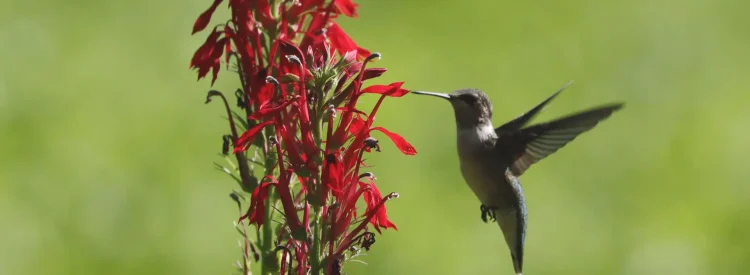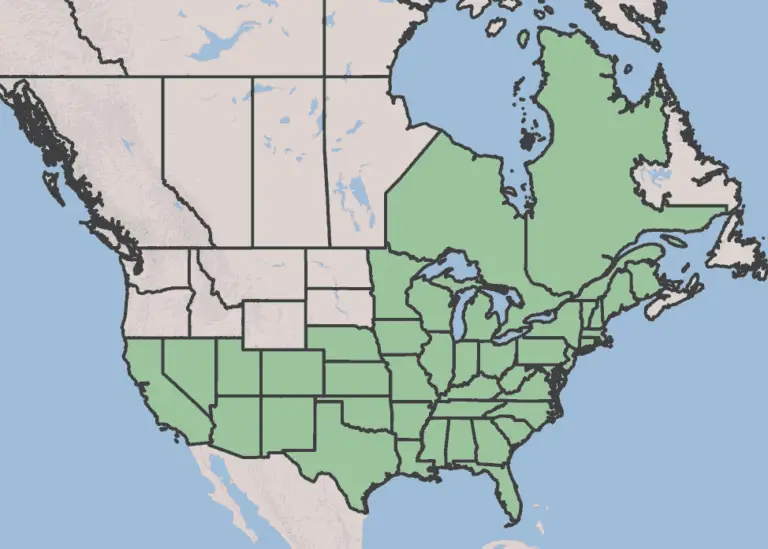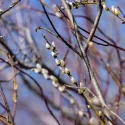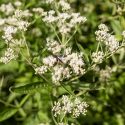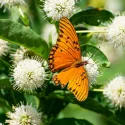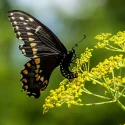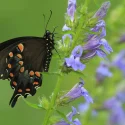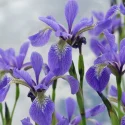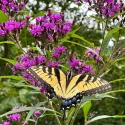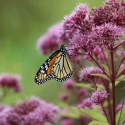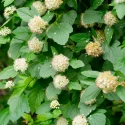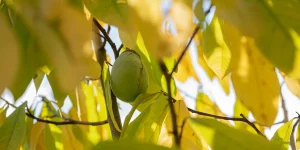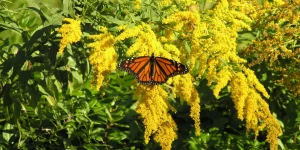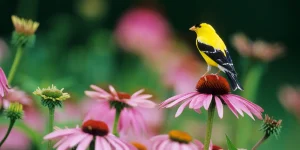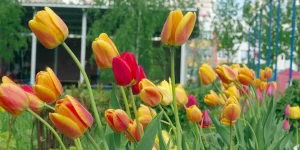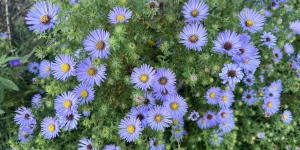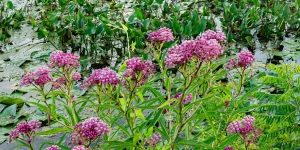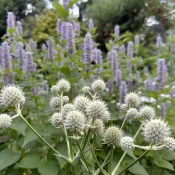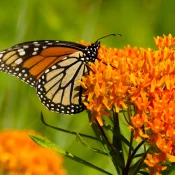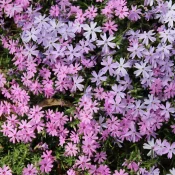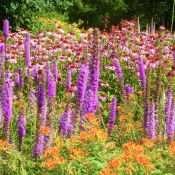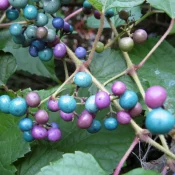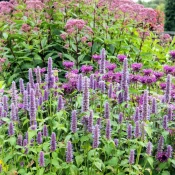If you want hummingbirds in your garden, plant this flower immediately. Cardinal flower sends up a tall, straight stalk which it then covers in tiny red flowers filled with nectar. Cardinal flowers like sun to part sun and need consistent water to thrive. Plant Cardinal flowers in groups of five (ideally) and watch hummingbirds zip around all summer. Scroll below for planting tips.
Cardinal flowers are summer treats to have in the garden. Their tall stalks offer 360 degrees of nectar access for pollinators—including hummingbirds. They also love wet areas, so plant these in your rain garden, along streams or ponds, or even near gutter downspouts. In this article, we will cover ideas on where to plant Cardinal flower so you’ll feel confident about planting some in your garden.
New to native?
Before lawns and landscaping, native plants were here. They’ve fed birds, bees, and butterflies for thousands of years—and they’ll do the same in your yard. The best part? They’re easier to grow than you think.
Let’s keep digging in with a question:
Why do hummingbirds love cardinal flower so much?
These flowers have evolved to be an ideal hummingbird nectar food source. Here are three reasons why these plants are hummingbird favorites:
Cardinal flowers are tallish—2-4 feet—perfect for hummingbird access
The height of the plant makes it perfect for hummingbird snacking. The 2-3 foot height of cardinal flowers put them high enough for a hummingbird to easily fly around and access the red flowers from all sides. As you can see from the video above, cardinal flowers are made to be hummingbird buffets.
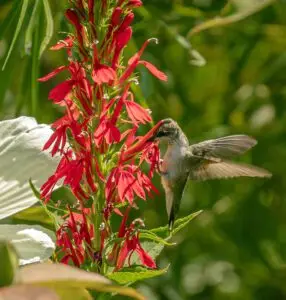
The cardinal flower shape is a hummingbird cup
Just looking at a cardinal flower shows how perfect it is for hummingbirds—its flowers are shaped to be hummingbird cups. The individual flowers on the cardinal flower stalk tip slightly up to contain the nectar within, while the shape of the flowers is perfect for a hummingbird’s beak.
Red is a favorite color of hummingbirds
Have you ever noticed that plastic hummingbird feeders are often red? This is because hummingbird eyesight is attuned to seeing red, yellow, orange, and pink colors. The reason may be that these colored flowers have the sweetest nectar.
The Brandywine Conservancy states, “Some reports indicate that blossoms in these colors are higher in sucrose—a form of sugar that hummingbirds can fully metabolize.” Love knowing that hummingbirds are looking for the sweetest flowers ❤️
Butterflies love cardinal flower, too
Cardinal flower nectar is also a sweet treat for butterflies. Butterflies and hummingbirds are both after the flower nectar held within a cardinal flower petal cup.
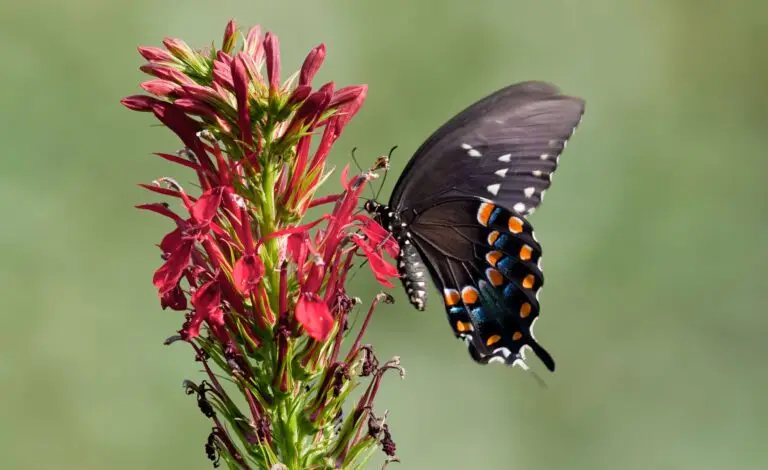
Where to plant cardinal flowers
Cardinal flowers’ native habitat includes meadows or the banks of streams or waterways. Which is why…
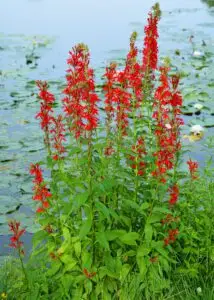
Cardinal flowers need consistent water
Cardinal flowers need consistent moisture to flourish; if the soil dries out, the plant may die. Their native habitats are along stream edges or wet meadows. Cardinal flowers are happiest in moist garden locations, like an area near a gutter downspout or where water tends to collect after the rain. Rain gardens are great places, too.
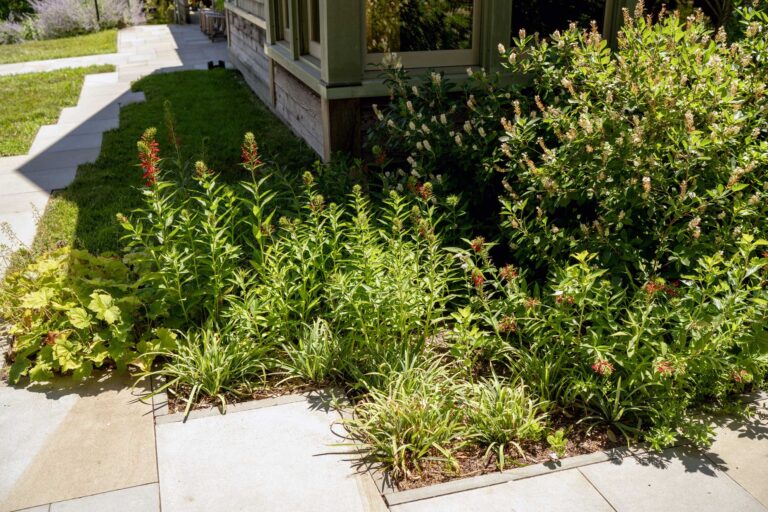
Where is cardinal flower native?
Cardinal flower is native to almost all of the United States and half of Canada. Plant away, native plant lovers!
How to grow cardinal flower
As long as we plant native plants in areas that mimic their natural habitat, they will thrive. For cardinal flowers, this means part sun to full sun and consistent moisture.
Grow cardinal flower from seeds
Cardinal flower seeds are incredibly tiny, so when you get a seed packet, you get thousands of seeds.
- For just $4.95, you can get a packet of 2,000 Cardinal Flower seeds from Everwilde Farms
- You can also buy a packet for $4.95 from American Meadows
Plant cardinal flower seeds in the fall
According to Everwilde, “Direct sow cardinal flower seeds in late fall, planting on the surface of the soil since these seeds need light to germinate.” In the spring, the seedlings will emerge. Keep them watered regularly during their first year to get them established.
Plant cardinal flower seeds in the spring
Cardinal flower seeds need to be cold for 30-60 days before they wake up and start to grow. (This type of cold nap before seeds wake up is called “dry stratification.”) This cold napping period mimics what these seeds experience in the winter, out in the wild.
If you get seeds from a cardinal flower in the fall or winter, you can mimic the wild indoors! Here’s how (steps from Prairie Nursery):
- Store seeds in Ziploc bags in a refrigerator, or in a rodent-proof container in an unheated building (like a garage) over winter for 30-120 days
- Most prairie grasses and wildflowers—like Cardinal flower—require only 30 to 60 days of dry stratification to break seed dormancy
After their cold nap, it’s time to plant the seeds.
To start indoors:
- Sow the seed 6-8 weeks before the last frost of spring
- Keep the soil lightly moist until germination (water in a spray bottle works well)
- Transplant the seedlings as soon as there is no chance of frost
- Water daily on dry days for the first month to get them established
Grow cardinal flower from plants
There are many ways to find cardinal flower plants for your garden. Here are four reliable ways to find some:
Where can I find seeds and plants?
Finding native plants can be challenging (we partly blame Marie Antoinette.) To make it easier, we’ve assembled four sourcing ideas.
300+ native nurseries make finding one a breeze
Explore 100+ native-friendly eCommerce sites
Every state and province has a native plant society; find yours
Online Communities
Local Facebook groups are a great plant source
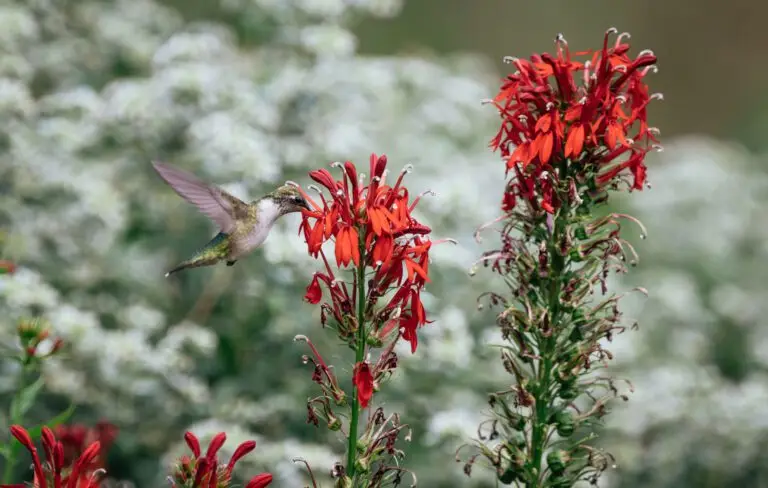
Cardinal Flower is deer-proof
Deer do NOT eat Cardinal Flower. If you’re worried about deer nibbling your garden, planting Cardinal Flower is a good native gardening choice.
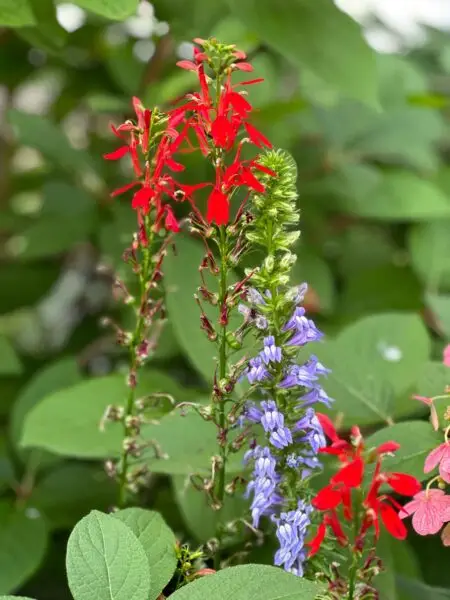
Cardinal flower vs. great blue lobelia
Cardinal flowers are related to another pollinator favorite: great blue lobelia. Both are in the Lobelia genus, make tall stalks, and are covered with flowers.
As you can see, their color difference is clear (the cardinal flower is red, and GBL is blue-purple), and their flower shapes are different.
What are good cardinal flower pairings?
There are so many other hummingbird and butterfly-friendly plants that look great with cardinal flowers and like the same water-heavy area. Here are some inspiring plants to pair in your garden:
Native plants to pair with cardinal flower
Cardinal flower is a beautiful and easy-to-grow plant that’s perfect for any garden. By following the simple care tips we’ve shared, you can enjoy its bright red blooms for years to come. To get more ideas on native plant gardening, explore our native plant library, visit our guide to the Best Native Plants for Rain Gardens or keep exploring our thematic guides below. Happy planting!
Sources
- Harris, Marjorie. Botanica North America: The Illustrated Guide to Our Native Plants, Their Botany, History, and the Way They Have Shaped Our World. (2003), 89-90.
- Johnson, Lorraine. 100 Easy-to-Grow Native Plants for American Gardens in Temperate Zones. (1999), 40.
- Johnson, Lorraine and Colla, Sheila. A Northern’s Guide to Native Plants and Pollinators. (2023), 120.
- Nelson, Gil. Best Native Plants for Southern Gardens: A Handbook for Gardeners, Homeowners, and Professionals. (2010).
- USDA Plants Database, Cardinal Flower.
What if your feed was actually good for your mental health?
Give your algorithm a breath of fresh air and follow us.
